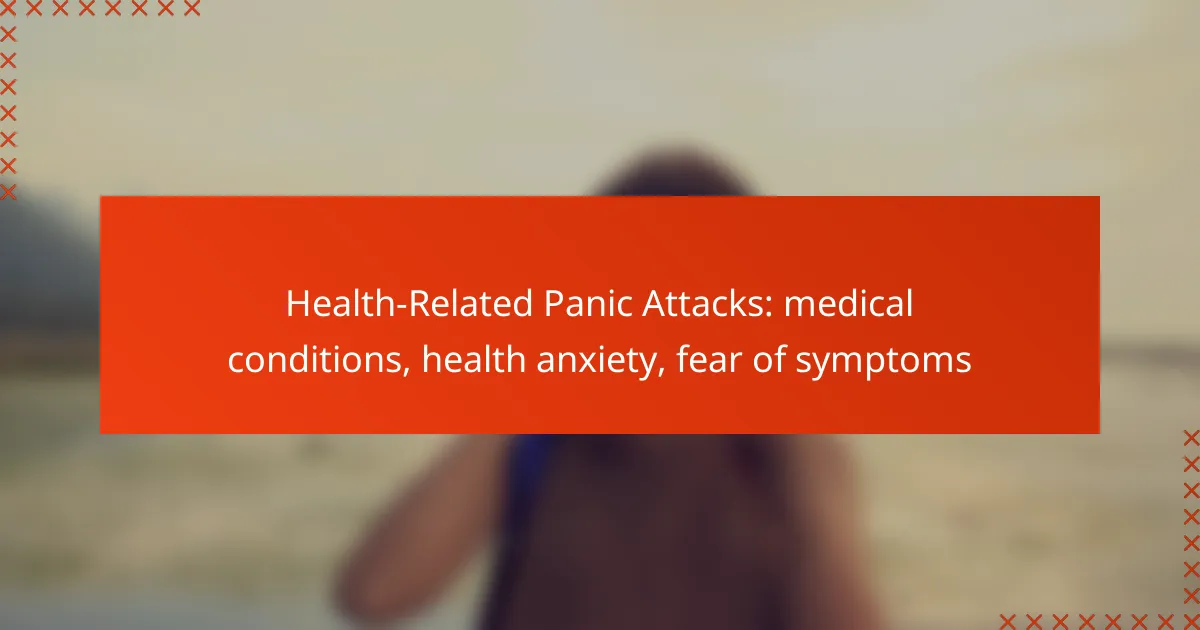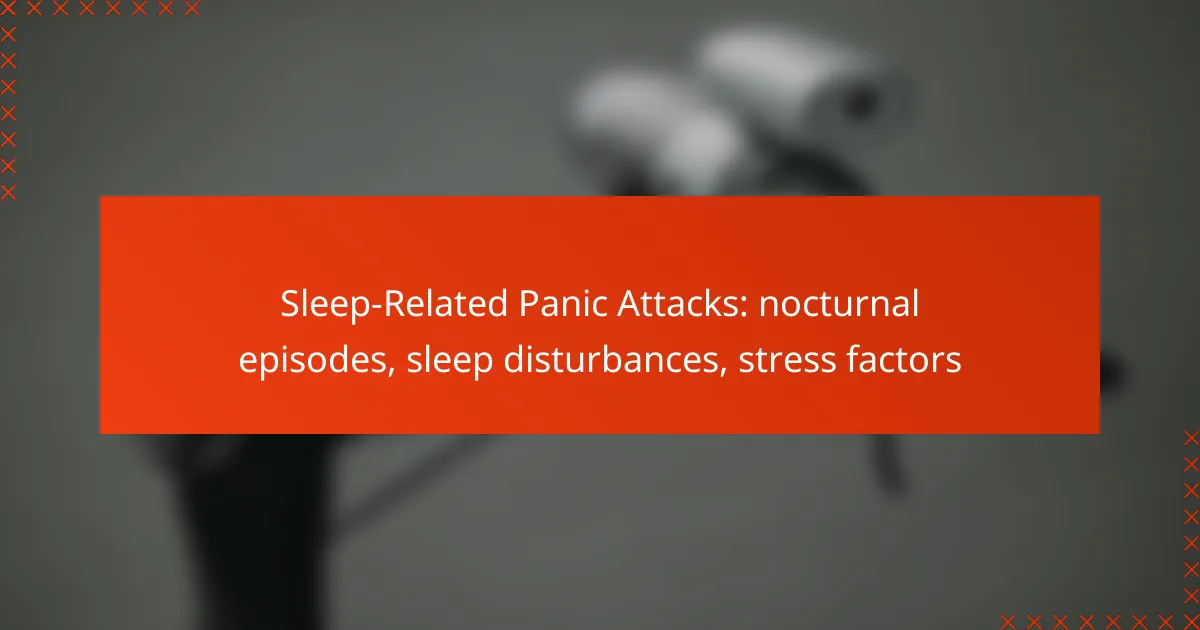Health-related panic attacks often stem from health anxiety, where individuals become overly concerned about their physical well-being. This persistent worry can trigger intense fear responses, leading to symptoms that resemble panic attacks, thereby creating a vicious cycle of anxiety and physical distress. Understanding this connection is crucial for effective management and treatment.

What are the treatment options for health-related panic attacks in the UK?
Treatment options for health-related panic attacks in the UK include various therapeutic approaches, medications, mindfulness practices, and support systems. These methods aim to alleviate anxiety symptoms and improve overall mental well-being.
Cognitive Behavioral Therapy (CBT)
Cognitive Behavioral Therapy (CBT) is a widely used treatment for health-related panic attacks. It focuses on identifying and changing negative thought patterns that contribute to anxiety and panic symptoms.
CBT typically involves structured sessions with a trained therapist, where patients learn coping strategies and techniques to manage their fears. This therapy can be effective in reducing the frequency and intensity of panic attacks.
Medication options
Medication can be a helpful component in treating health-related panic attacks, particularly when symptoms are severe. Common options include selective serotonin reuptake inhibitors (SSRIs) and benzodiazepines, which can help regulate mood and anxiety levels.
It’s essential to consult a healthcare professional to determine the most suitable medication and dosage, as individual responses can vary. Regular follow-ups are crucial to monitor effectiveness and adjust treatment as needed.
Mindfulness techniques
Mindfulness techniques can significantly aid in managing health-related panic attacks by promoting relaxation and present-moment awareness. Practices such as deep breathing, meditation, and progressive muscle relaxation can help reduce anxiety levels.
Incorporating mindfulness into daily routines can enhance emotional resilience and provide tools to cope with panic symptoms when they arise. Many resources, including apps and local classes, are available to support individuals in learning these techniques.
Support groups
Support groups offer a valuable space for individuals experiencing health-related panic attacks to share their experiences and coping strategies. These groups can provide emotional support and reduce feelings of isolation.
In the UK, various organizations facilitate support groups, both in-person and online. Engaging with others who understand similar challenges can foster a sense of community and encourage recovery.

How can health anxiety lead to panic attacks?
Health anxiety can trigger panic attacks by causing individuals to excessively worry about their health, leading to heightened stress responses. This constant fear of serious medical conditions can create a cycle where anxiety manifests physically, resulting in symptoms that mimic those of panic attacks.
Understanding health anxiety
Health anxiety, often referred to as hypochondria, involves an overwhelming preoccupation with having a serious illness despite medical reassurance. Individuals may frequently interpret normal bodily sensations as signs of severe health issues, leading to persistent worry and stress.
This condition can stem from various factors, including personal health experiences, family history of illness, or exposure to health-related information. Understanding the root causes can help in addressing the anxiety effectively.
Symptoms of health anxiety
Symptoms of health anxiety can vary but often include excessive worry about health, frequent checking of the body for signs of illness, and seeking repeated medical consultations. Individuals may also experience physical symptoms such as increased heart rate, sweating, or gastrointestinal distress, which can further fuel their anxiety.
Common pitfalls include ignoring medical advice and continuing to seek unnecessary tests or treatments. Recognizing these symptoms is crucial for managing health anxiety and preventing the escalation into panic attacks.
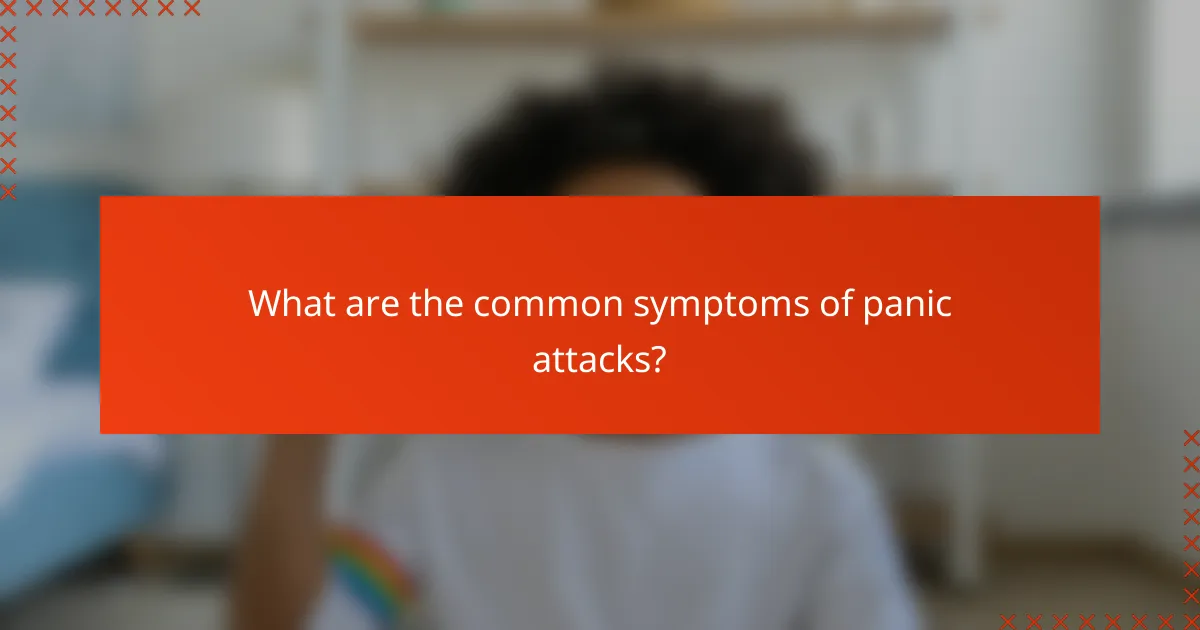
What are the common symptoms of panic attacks?
Panic attacks often manifest through a range of physical and emotional symptoms. Recognizing these symptoms can help individuals understand their experiences and seek appropriate support.
Physical symptoms
Physical symptoms of panic attacks can include rapid heartbeat, shortness of breath, sweating, trembling, and dizziness. These sensations can be intense and may mimic serious medical conditions, leading to increased anxiety. It’s common for individuals to feel chest pain or discomfort, which can further exacerbate their fear of having a heart attack.
In addition to these symptoms, some people may experience gastrointestinal issues, such as nausea or an upset stomach. Understanding that these physical reactions are part of a panic attack can help individuals manage their responses more effectively.
Emotional symptoms
Emotional symptoms during a panic attack often include feelings of impending doom, fear of losing control, or fear of dying. These overwhelming emotions can lead to a heightened state of anxiety, making it difficult to think clearly or rationally. Individuals may feel detached from reality or experience a sense of unreality, known as depersonalization.
It’s crucial to recognize that these emotional symptoms are temporary and typically subside once the panic attack passes. Practicing grounding techniques, such as focusing on breathing or engaging in mindfulness, can help alleviate these feelings during an episode.

How can lifestyle changes help manage panic attacks?
Lifestyle changes can significantly reduce the frequency and intensity of panic attacks by promoting overall well-being and resilience. Incorporating regular exercise, a balanced diet, and good sleep hygiene can help alleviate anxiety and improve emotional regulation.
Exercise and physical activity
Regular exercise is a powerful tool for managing panic attacks. Engaging in physical activity releases endorphins, which can elevate mood and reduce stress levels. Aim for at least 150 minutes of moderate aerobic activity each week, such as brisk walking or cycling.
Incorporating strength training exercises two to three times a week can also be beneficial. Activities like weightlifting or yoga not only improve physical health but also enhance mental clarity and emotional stability.
Dietary adjustments
A balanced diet plays a crucial role in managing anxiety and panic attacks. Focus on whole foods, including fruits, vegetables, whole grains, and lean proteins, while minimizing processed foods and added sugars. Foods rich in omega-3 fatty acids, such as salmon and walnuts, can support brain health and reduce anxiety symptoms.
Staying hydrated is equally important; aim for at least 2 liters of water daily. Limiting caffeine and alcohol can also help, as these substances may exacerbate anxiety and trigger panic attacks.
Sleep hygiene
Good sleep hygiene is essential for managing panic attacks, as lack of sleep can heighten anxiety levels. Establish a consistent sleep schedule by going to bed and waking up at the same time each day. Aim for 7 to 9 hours of quality sleep per night to support mental health.
Create a relaxing bedtime routine that may include activities like reading or meditation. Avoid screens and stimulants before bed to improve sleep quality and reduce the likelihood of panic attacks during the night.
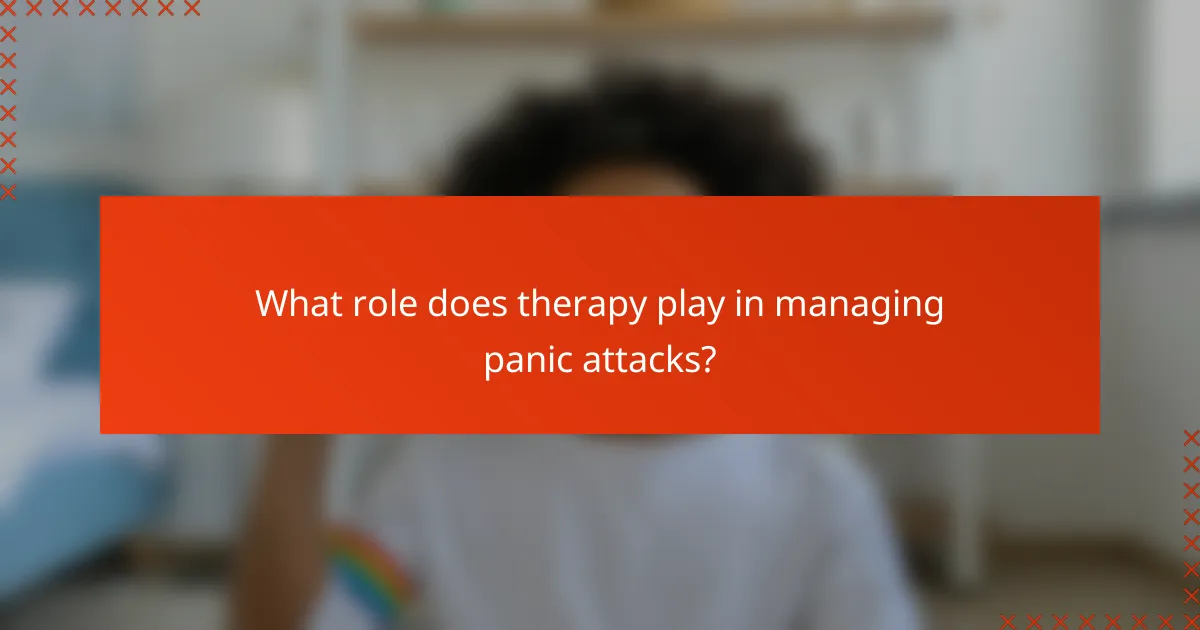
What role does therapy play in managing panic attacks?
Therapy plays a crucial role in managing panic attacks by helping individuals understand their symptoms and develop coping strategies. Through various therapeutic approaches, patients can address underlying issues related to anxiety and fear, ultimately reducing the frequency and intensity of panic attacks.
Types of therapy
Several types of therapy are effective for managing panic attacks, with Cognitive Behavioral Therapy (CBT) being one of the most widely used. CBT focuses on identifying and changing negative thought patterns and behaviors associated with panic. Other options include exposure therapy, which gradually exposes individuals to their fears in a controlled environment, and mindfulness-based therapies that promote relaxation and awareness.
Support groups and talk therapy can also be beneficial, offering a space for individuals to share experiences and learn from others. Each type of therapy may suit different individuals based on their specific needs and preferences.
Effectiveness of therapy
The effectiveness of therapy in managing panic attacks varies among individuals but is generally positive. Many people experience significant reductions in panic symptoms after several sessions, often within a few weeks to months. Studies suggest that a combination of therapy and medication can enhance outcomes for those with severe symptoms.
It is essential to maintain consistency in therapy sessions and actively engage in the techniques learned. Patients should also be aware of potential setbacks and remain patient with their progress, as recovery can take time and may require adjustments to their therapeutic approach.

What are the triggers for panic attacks related to health?
Panic attacks related to health can be triggered by various factors, including stressful life events and underlying medical conditions. Understanding these triggers is crucial for managing health anxiety and mitigating the fear of symptoms.
Stressful life events
Stressful life events can significantly contribute to health-related panic attacks. Situations such as the loss of a loved one, job changes, or major life transitions can heighten anxiety levels, making individuals more sensitive to bodily sensations. For example, someone experiencing a divorce may become hyper-aware of physical symptoms, interpreting them as signs of serious illness.
To manage anxiety during stressful times, individuals should consider implementing stress-reduction techniques. Practices such as mindfulness, regular exercise, and maintaining a support network can help alleviate feelings of panic. Avoiding excessive consumption of caffeine and alcohol during these periods can also reduce anxiety levels.
Medical conditions
Certain medical conditions can trigger panic attacks, particularly those that affect the cardiovascular or respiratory systems. Conditions such as asthma, heart disease, or hyperthyroidism may cause symptoms that mimic panic attacks, such as shortness of breath or rapid heartbeat. This overlap can lead to increased anxiety about one’s health.
It’s essential for individuals with known medical conditions to work closely with healthcare providers to manage their symptoms effectively. Regular check-ups and open communication about any new or worsening symptoms can help reduce anxiety. Additionally, learning about the condition and its symptoms can empower individuals, allowing them to differentiate between normal health issues and panic-related symptoms.
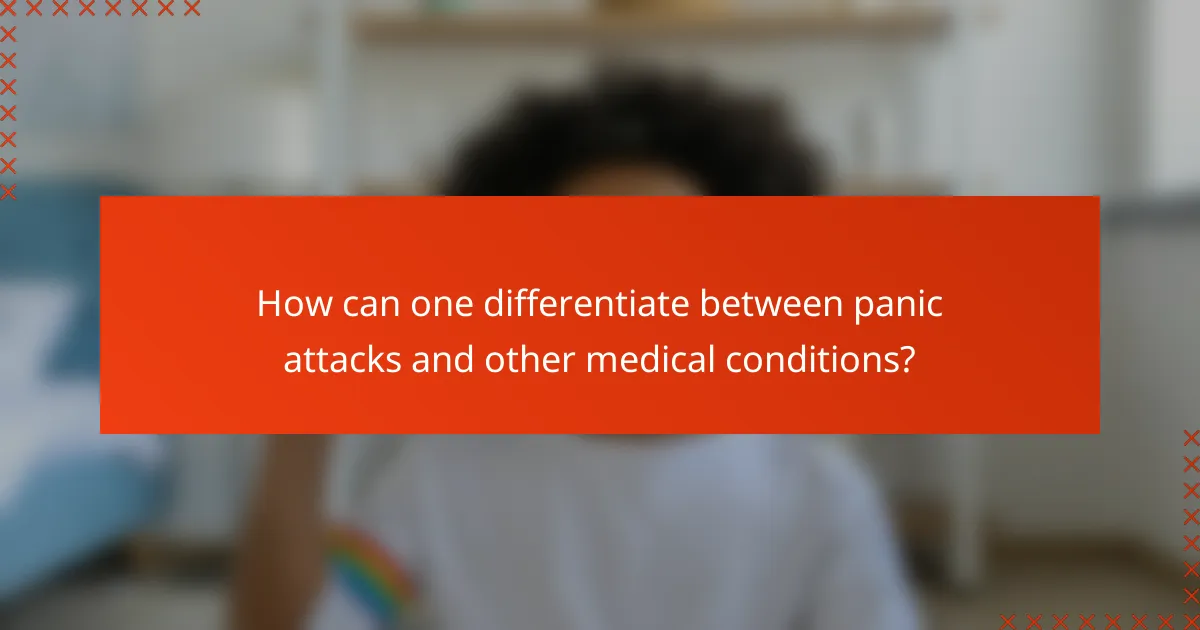
How can one differentiate between panic attacks and other medical conditions?
Panic attacks can be distinguished from other medical conditions by recognizing their specific symptoms and triggers. While panic attacks often involve intense fear and physical symptoms like rapid heartbeat, other medical conditions may present differently or have additional signs that are not typical of panic attacks.
Understanding Panic Attack Symptoms
Panic attacks typically manifest with sudden feelings of intense fear or discomfort, often accompanied by physical symptoms such as chest pain, shortness of breath, sweating, and dizziness. These symptoms can mimic those of serious medical issues, leading to confusion. It’s crucial to note that panic attack symptoms usually peak within minutes and then subside, whereas symptoms of other conditions may persist longer.
Identifying Other Medical Conditions
Other medical conditions, such as heart disease or respiratory issues, may present with similar symptoms but often include additional signs. For instance, chest pain from a heart condition may be accompanied by nausea or pain radiating to the arm. Understanding the context of symptoms, such as their duration and associated factors, can help in distinguishing panic attacks from other health issues.
When to Seek Medical Help
If symptoms are severe or persistent, it is essential to seek medical attention. A healthcare provider can conduct tests to rule out serious conditions and provide a proper diagnosis. If panic attacks are suspected, discussing symptoms openly with a doctor can lead to effective treatment options, such as therapy or medication.
